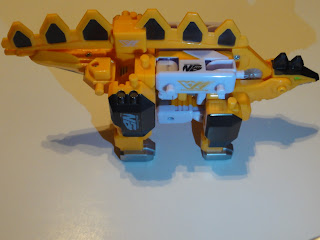Today, I thought I'd take a look at Needle Stego, the "N" of the Mugen Gattai series, which I happened across at a recycle shop just before returning to America.
Out of the box, we have the core robot (known as a Mugenroid) and an assortment of pieces (called bine parts) that will combine to form its two modes. Right away, I can feel the quality of the plastic and really dig the simple, earthy color scheme.
Also included are transformation instructions, an information card for the character's dino mode, and a sticker sheet. I'd been reluctant to apply the stickers after how terrible the candy toys turned out, but for the sake of this review I finally put them on. I can't really say it added anything to the toy, but they're much better than the candy toy apps.
The instructions are in Japanese, but every step is illustrated clearly and I don't imagine anyone would have trouble following along.
Here's the Mugenroid before the sticker apps were applied. He's got articulation at the shoulders, hips, and knees. The head can fold down and the arms forward. The pegs at the feet and shoulders can be turned. All joints ratchet at 45 or 90 degrees. This is the standard form for all Mugenroids of this series. Quite a lot of moving parts for something so small.
A neat little detail that most of the Gattai series robots share is their letter printed on the side of their heads.
Now with stickers applied, we bring up the legs and bend the knees in preparation for Needle Stego's machine mode...
The helicopter mode works pretty well for me. It's a solid toy and doesn't suffer from the candy toys' tendency to have useless or out of place parts. Each section serves some point in fleshing out the overall toy. The propeller spins in this mode, but again it's a ratcheted joint so while it displays quite nicely in any position, it turns with a sort of jerky motion.
I complained about the candy toys having faces in weird spots, and the same is true for this toy. The stegosaurus face is quite obvious. Yet for some reason it doesn't bother me as much. I look at it as a subtle nod that there is more to this toy than a model helicopter.
Somewhat less forgivable is the gap on the main section that exposes the arms of the Mugenroid below. I feel it just reveals too much about the inner workings of the toy. I usually shift the smaller leg parts down a peg to cover this up.
To form dino mode, we fold up the legs behind the body, shift the arms forward and flip the head down. Then, we make sure to flip all the movable pegs outward. The result is essentially a square block.
Dino mode is a very sturdy, bulky toy. He definitely feels like he could do some major damage.
Due to a small peg that attaches the spikes to the head, only the legs of Needle Stego can move. Still, four points on what is effectively a brick isn't too bad. Certainly more than you get out of your average sentai mecha.
Again, there's something aesthetically pleasing about details from the other mode bleeding over, both in the head and tail of the figure.
A common complaint among collectors regarding the candy toy series is the gradual decline in quality of materials. After handling Needle Stego, I can see those arguments hold some weight. The Gattai series has more heft and durability than its successors. Add to that the fact that they come painted with enough detail to make sticker apps unnecessary and it would seem the odds are stacked wholly in favor of seeking out these older toys.
In terms of play value, however, I would still give the edge to the candy toys. Pieces in the Gattai series are generally larger and provide fewer connection points to play with. In addition, toys like Needle Stego were designed as stand alone mecha. Though there are some combinations to be made in the Gattai series, things such as color scheme and cross-compatibility may be an issue. In contrast, the candy toy releases were designed with combination and customization in mind, with each set having a consistant theme and color and each toy having as many as three official forms.
All that said, Needle Stego is a great toy and a welcome addition to my collection. He's fun to transform and displays great in both modes. I admire the detail and quality of the toy and intend on seeking out others from the Gattai series to add to my shelf.
















i want mungenbine
ReplyDelete